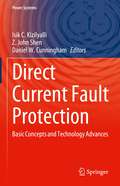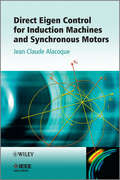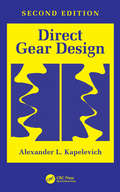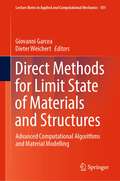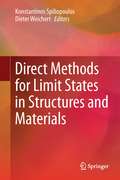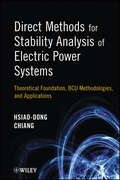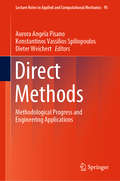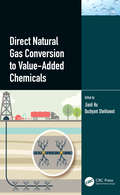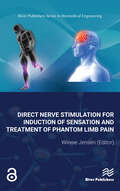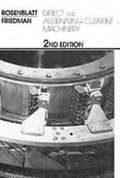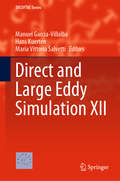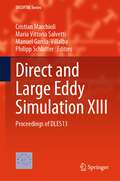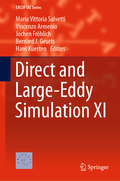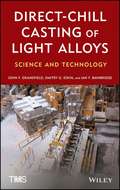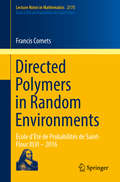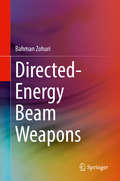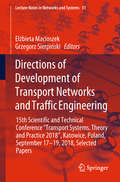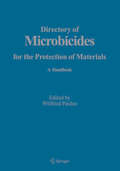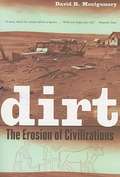- Table View
- List View
Direct Current Fault Protection: Basic Concepts and Technology Advances (Power Systems)
by Daniel W. Cunningham Isik C. Kizilyalli Z. John ShenThe lack of effective DC fault protection technology remains a major barrier for the DC paradigm shift. In addressing the key challenges, Direct Current Fault Protection: Basic Concepts and Technology Advances starts with an introduction to the advantages of DC power systems before moving on to an in-depth review of DC fault protection technologies, including mechanical circuit breaker (MCB), solid-state circuit breaker (SSCB), hybrid circuit breaker (HCB), converter based (breakerless) protection, and fault current limiter (FCL). Coverage includes a comprehensive comparison of various DC fault interruption technologies and their suitable applications, state-of-the-art DC fault protection concepts and advances in research, identification of fundamental challenges and future directions in the field, and commercialization aspects. This book will be a valuable reference for practicing engineers, researchers, and graduate students in the field of power electronics and DC power systems.
Direct Eigen Control for Induction Machines and Synchronous Motors
by Jean Claude AlacoqueClear presentation of a new control process applied to induction machine (IM), surface mounted permanent magnet synchronous motor (SMPM-SM) and interior permanent magnet synchronous motor (IPM-SM)Direct Eigen Control for Induction Machines and Synchronous Motors provides a clear and consise explanation of a new method in alternating current (AC) motor control. Unlike similar books on the market, it does not present various control algorithms for each type of AC motor but explains one method designed to control all AC motor types: Induction Machine (IM), Surface Mounted Permanent Magnet Synchronous Motor (SMPM-SM) (i.e. Brushless) and Interior Permanent Magnet Synchronous Motor (IPM-SM). This totally new control method can be used not only for AC motor control but also to control input filter current and voltage of an inverter feeding an AC motor.Accessible and clear, describes a new fast type of motor control applied to induction machine (IM), surface mounted permanent magnet synchronous motor (SM-PMSM) and interior permanent magnet synchronous motor (I-PMSM) with various examplesSummarizes a method that supersedes the two known direct control solutions - Direct Self Control and Direct Torque Control - to be used for AC motor control and to control input filter current and voltage of an inverter feeding an AC motorPresents comprehensive simulations that are easy for the reader to reproduce on a computer. A control program is hosted on a companion websiteThis book is straight-forward with clear mathematical description. It presents simulations in a way that is easy to understand and to reproduce on a computer, whilst omitting details of practical hardware implementation of control, in order for the main theory to take focus. The book remains concise by leaving out description of sensorless controls for all motor types. The sections on "Control Process", "Real Time Implementation" and "Kalman Filter Observer and Prediction" in the introductory chapters explain how to practically implement, in real time, the discretized control with all three types of AC motors. In order, this book describes induction machine, SMPM-SM, IPM-SM, and, application to LC filter limitations. The appendixes present: PWM vector calculations; transfer matrix calculation; transfer matrix inversion; Eigen state space vector calculation; and, transition and command matrix calculation.Essential reading for Researchers in the field of drive control; graduate and post-graduate students studying electric machines; electric engineers in the field of railways, electric cars, plane surface control, military applications. The approach is also valuable for Engineers in the field of machine tools, robots and rolling mills.
Direct Gear Design
by Alexander L. KapelevichThe updated and improved second edition of Direct Gear Design details a nonstandard gear design approach that makes it possible to significantly improve gear drive performance. Providing engineers with gear design solutions beyond standard limits, this book delivers engineers with practical and innovative solutions to optimize gearing technologies.The majority of modern gears are over-standardized, not allowing gear design engineers to see possible gear design solutions outside of standard limits. The book explores opportunities to improve and optimize gears beyond these limitations. The method of Direct Gear Design has been proven to maximise gear drive performance, increase transmission load capacity and efficiency, and reduce size and weight. Discussing the use of gears made from powder metal and plastic, the book surveys gear manufacture and makes use of extensive references to encourage further exploration of gear design innovation. Additionally, the book provides an overview of manufacturing technologies and traditional gear design, as well as covering topics such as asymmetric gears, tolerance selection and measurement methods of custom gears.Written accessibly, with a focus on practical examples, this fully updated edition will serve as a guidebook for all professionals exploring high-performance gearing system technologies.
Direct Methods for Limit State of Materials and Structures: Advanced Computational Algorithms and Material Modelling (Lecture Notes in Applied and Computational Mechanics #101)
by Dieter Weichert Giovanni GarceaThis book provides an overview of direct methods, such as limit and shakedown analysis, which are intended for avoiding cumbersome step-by-step calculations to determine the limit states of mechanical structures under monotone, cyclic or variable actions with unknown loading history. The book comprises several contributions that demonstrate how tremendous advances in numerical methods, especially in optimization, have contributed to the success of direct methods and their applicability to practical engineering problems in structural mechanics and mechanics of materials. The contents reflect the outcomes of the workshop “Direct Methods for Limit State of Materials and Structures,” held in Cosenza, Italy in June 2022.
Direct Methods for Limit States in Structures and Materials
by Konstantinos Spiliopoulos Dieter WeichertKnowing the safety factor for limit states such as plastic collapse, low cycle fatigue or ratcheting is always a major design consideration for civil and mechanical engineering structures that are subjected to loads. Direct methods of limit or shakedown analysis that proceed to directly find the limit states offer a better alternative than exact time-stepping calculations as, on one hand, an exact loading history is scarcely known, and on the other they are much less time-consuming. This book presents the state of the art on various topics concerning these methods, such as theoretical advances in limit and shakedown analysis, the development of relevant algorithms and computational procedures, sophisticated modeling of inelastic material behavior like hardening, non-associated flow rules, material damage and fatigue, contact and friction, homogenization and composites.
Direct Methods for Stability Analysis of Electric Power Systems
by Hsiao-Dong ChiangLearn how to implement BCU methods for fast direct stability assessments of electric power systemsElectric power providers around the world rely on stability analysis programs to help ensure uninterrupted service to their customers. These programs are typically based on step-by-step numerical integrations of power system stability models to simulate system dynamic behaviors. Unfortunately, this offline practice is inadequate to deal with current operating environments. For years, direct methods have held the promise of providing real-time stability assessments; however, these methods have presented several challenges and limitations.This book addresses these challenges and limitations with the BCU methods developed by author Hsiao-Dong Chiang. To date, BCU methods have been adopted by twelve major utility companies in Asia and North America. In addition, BCU methods are the only direct methods adopted by the Electric Power Research Institute in its latest version of DIRECT 4.0.Everything you need to take full advantage of BCU methods is provided, including:Theoretical foundations of direct methodsTheoretical foundations of energy functionsBCU methods and their theoretical foundationsGroup-based BCU method and its applicationsNumerical studies on industrial models and dataArmed with a solid foundation in the underlying theory of direct methods, energy functions, and BCU methods, you'll discover how to efficiently solve complex practical problems in stability analysis. Most chapters begin with an introduction and end with concluding remarks, making it easy for you to implement these tested and proven methods that will help you avoid costly and dangerous power outages.
Direct Methods: Methodological Progress and Engineering Applications (Lecture Notes in Applied and Computational Mechanics #95)
by Dieter Weichert Aurora Angela Pisano Konstantinos Vassilios SpiliopoulosThis book provides an overview of direct methods such as limit and shakedown analysis, which are intended to do away with the need for cumbersome step-by-step calculations and determine the loading limits of mechanical structures under monotone, cyclic or variable loading with unknown loading history. The respective contributions demonstrate how tremendous advances in numerical methods, especially in optimization, have contributed to the success of direct methods and their practical applicability to engineering problems in structural mechanics, pavement and general soil mechanics, as well as the design of composite materials. The content reflects the outcomes of the workshop “Direct Methods: Methodological Progress and Engineering Applications,” which was offered as a mini-symposium of PCM-CMM 2019, held in Cracow, Poland in September 2019.
Direct Natural Gas Conversion to Value-Added Chemicals
by Jianli Hu Dushyant ShekhawatDirect Natural Gas Conversion to Value-Added Chemicals comprehensively discusses all major aspects of natural gas conversion and introduces a broad spectrum of recent technological developments. Specifically, the book describes heterogeneous and homogeneous catalysis, microwave-assisted conversion, non-thermal plasma conversion, electrochemical conversion, and novel chemical looping conversion approaches. Provides an excellent benchmark resource for the industry and academics Appeals to experienced researchers as well as newcomers to the field, despite the variety of contributing authors and the complexity of the material covered Includes all aspects of direct natural gas conversion: fundamental chemistry, different routes of conversion, catalysts, catalyst deactivation, reaction engineering, novel conversion concepts, thermodynamics, heat and mass transfer issues, system design, and recent research and development Discusses new developments in natural gas conversion and future challenges and opportunities This book is as an excellent resource for advanced students, technology developers, and researchers in chemical engineering, industrial chemistry, and others interested in the conversion of natural gas.
Direct Nerve Stimulation for Induction of Sensation and Treatment of Phantom Limb Pain (River Publishers Series In Biomedical Engineering Ser.)
by Winnie JensenThe amputation of a limb is a surgical intervention used as a last resort to remove irreparably damaged, diseased, or congenitally malformed limbs where retention of the limb is a threat to the well-being of the individual. The procedure traumatically alters the body image, but often leaves sensations that refer to the missing body part, the phantom limb. In 50-80% of cases, these sensations are perceived as painful and referred to as ‘Phantom Limb Pain’.Direct Nerve Stimulation for Induction of Sensation and Treatment of Phantom Limb Pain provides an overview of research, experiences and results for the design, development and test of hardware and software components, and the ambition to safely implant and evaluate a novel neural interface system to combat phantom limb pain in an amputee volunteer subject.
Direct and Alternating Current Machinery
by Jack Rosenblatt M. FriedmanDirect and Alternating Current Machinery Second Edition by Jack Rosenblatt, M. Friedman.
Direct and Large Eddy Simulation XII: Dles 2019 (ERCOFTAC Series #27)
by Hans Kuerten Maria Vittoria Salvetti Manuel García-VillalbaThis book gathers the proceedings of the 12th instalment in the bi-annual Workshop series on Direct and Large Eddy Simulation (DLES), which began in 1994 and focuses on modern techniques used to simulate turbulent flows based on the partial or full resolution of the instantaneous turbulent flow structure. With the rapidly expanding capacities of modern computers, this approach has attracted more and more interest over the years and will undoubtedly be further enhanced and applied in the future. Hybrid modelling techniques based on a combination of LES and RANS approaches also fall into this category and are covered as well. The goal of the Workshop was to share the state of the art in DNS, LES and related techniques for the computation and modelling of turbulent and transitional flows. The respective papers highlight the latest advances in the prediction, understanding and control of turbulent flows in academic and industrial applications.
Direct and Large Eddy Simulation XIII: Proceedings of DLES13 (ERCOFTAC Series #31)
by Maria Vittoria Salvetti Cristian Marchioli Philipp Schlatter Manuel Garcia-VillalbaThis book covers the diverse and cutting-edge research presented at the 13th ERCOFTAC Workshop on Direct and Large Eddy Simulation. The first section of the book focuses on Aerodynamics/Aeroacoustics, comprising eight papers that delve into the intricate relationship between fluid flow and aerodynamic performance. The second section explores the dynamics of Bluff/Moving Bodies through four insightful papers. Bubbly Flows, the subject of the third section, is examined through four papers. Moving on, the fourth section is dedicated to Combustion and Reactive Flows, presenting two papers that focus on the complex dynamics of combustion processes and the interactions between fluids and reactive species. Convection and Heat/Mass Transfer are the central themes of the fifth section, which includes three papers. These contributions explore the fundamental aspects of heat and mass transfer in fluid flows, addressing topics such as convective heat transfer, natural convection, and mass transport phenomena. The sixth section covers Data Assimilation and Uncertainty Quantification, featuring two papers that highlight the importance of incorporating data into fluid dynamic models and quantifying uncertainties associated with these models. The subsequent sections encompass a wide range of topics, including Environmental and Industrial Applications, Flow Separation, LES Fundamentals and Modelling, Multiphase Flows, and Numerics and Methodology. These sections collectively present a total of 23 papers that explore different facets of fluid dynamics, contributing to the advancement of the field and its practical applications.
Direct and Large-Eddy Simulation XI (ERCOFTAC #25)
by Jochen Fröhlich Hans Kuerten Bernard J. Geurts Vincenzo Armenio Maria Vittoria Salvetti<p>This book gathers the proceedings of the 11th workshop on Direct and Large Eddy Simulation (DLES), which was held in Pisa, Italy in May 2017. The event focused on modern techniques for simulating turbulent flows based on the partial or full resolution of the instantaneous turbulent flow structures, as Direct Numerical Simulation (DNS), Large-Eddy Simulation (LES) or hybrid models based on a combination of LES and RANS approaches. In light of the growing capacities of modern computers, these approaches have been gaining more and more interest over the years and will undoubtedly be developed and applied further. The workshop offered a unique opportunity to establish a state-of-the-art of DNS, LES and related techniques for the computation and modeling of turbulent and transitional flows and to discuss about recent advances and applications. <p>This volume contains most of the contributed papers, which were submitted and further reviewed for publication. They cover advances in computational techniques, SGS modeling, boundary conditions, post-processing and data analysis, and applications in several fields, namely multiphase and reactive flows, convection and heat transfer, compressible flows, aerodynamics of airfoils and wings, bluff-body and separated flows, internal flows and wall turbulence and other complex flows. </p>
Direct-Chill Casting of Light Alloys
by John F. Grandfield Dmitry G. Eskin Ian F. BainbridgeDirect-chill casting is the major production route for wrought aluminium and magnesium alloys that are later deformed (rolled, extruded, forged) to the final products. To aid in this process, this book provides comprehensive coverage on topics such as the history of process development in this field, industrial applications, including vertical and horizontal casting, melt preparation, fundamentals of solidification in DC casting, and more. The first book targeted for the industrial researcher and practitioner, it pulls together the practice and process of physics with the goal of improving process performance.
Direct-Fed Microbials and Prebiotics for Animals
by Todd R. Callaway Steven C. RickeThe practice of supplementing direct fed microbial and prebiotic additives to domestic animals during growth is becoming more widespread in food animal production. Beneficial effects particularly in cattle, pigs and poultry, including improved general health, foodborne pathogen reduction, more efficient food utilization, faster growth rate and increased milk and egg production are common results. The success associated with direct fed microbial and prebiotic applications in multiple species ensures their continued commercialization and the widespread use of such additives. However, several fundamental questions remain about how and why probiotic products work, and which kind of probiotic products are best for specific production scenarios. It appears that early establishment and retention of an ecological balance in the gastrointestinal tract is an important first step for an external biological additive to be effective in young animals. Therefore, it is possible that the effectiveness of direct fed microbials and prebiotics in some animal species may only be an indirect consequence of speeding up the establishment and succession of the dominant microflora characteristic of the adult gastrointestinal tract. Consequently, an understanding of the key processes during establishment of microflora in the gastrointestinal system that lead to the subsequent fermentation characteristics and ecological balance exhibited by the highly protective microflora is needed. Several additional areas of future research directions are also suggested for further development and implementation of these biological approaches as new molecular and drug delivery technologies become available. Continued research on direct fed microbials and prebiotics in general should markedly expand their commercial applications.
Direct-Fed Microbials and Prebiotics for Animals: Science and Mechanisms of Action
by Todd R. Callaway Steven C. RickeIn this exciting update, readers will learn how feeding direct-fed microbials (including eubiotics, postbiotics, prebiotics, and synbiotics) is becoming increasingly widespread during food animal production. Animal production must improve efficiency of growth, and the use of direct-fed microbial and prebiotic additives to domestic animals has become widely accepted and utilized. The benefits of probiotic-type approaches in cattle, pigs, fish, and poultry, include improved general animal health, reduced foodborne pathogen populations, increased growth rate and feed efficiency, improved milk and egg production, and have been reported world-wide. Successes from probiotic approaches in multiple species have ensured their adoption; however, several fundamental questions remain. Early establishment and retention of an ecological balance in the gastrointestinal tract is an important first step for an external biological additive to be effective in young animals, suggesting that some of the benefits of direct-fed microbials may be due to an early establishment of a “normal” native gut microbial population. Research has indicated that the establishment of a normal population can enhance gut epithelial integrity, preventing inflammation and improving animal health. Thus, it is important that we understand the key processes that occur during the establishment of the gut microbial population that can impact gastrointestinal fermentation and provide protection against pathogens of the animals and of human consumers. Knowing how these processes work and how they impact animal energy and protein expenditures can guide further improvements of available and future commercial products. Exciting research opportunities are discussed in this book, examining different characteristics of DFMs that are fed to animals to meet different production demands in different production scenarios (e.g., beef versus dairy versus swine versus fin fish). The advent of molecular and next-generation sequencing offers methods of developing tailored DFMs, and of early detection of successful DFM establishment in the gut. These techniques will further deepen our insight into understanding the microbial population of the gut and how these populations impact animal health, food safety, and sustainability of animal-derived protein production.
Directed Energy Weapons
by Bahman ZohuriThis book delves deeply into the real-world technologies behind the 'directed energy weapons' that many believe exist only within the confines of science fiction. On the contrary, directed energy weapons such as high energy lasers are very real, and this book provides a crash course in all the physical and mathematical concepts that make these weapons a reality. Written to serve both scientists researching the physical phenomena of laser effects, as well as engineers focusing on practical applications, the author provides worked examples demonstrating issues such as how to solve for heat diffusion equation for different boundary and initial conditions. Several sections are devoted to reviewing and dealing with solutions of diffusion equations utilizing the aid of the integral transform techniques. Ultimately this book examines the state-of-the-art in currently available high energy laser technologies, and suggests future directions for accelerating practical applications in the field.
Directed Evolution for Development and Production of Bioactive Agents
by Daniel TalmageIn 2012, the Defense Intelligence Agency (DIA) approached the National Research Council and asked that a committee be formed to develop a list of workshop topics to explore the impact of emerging science and technology. This book explains the objectives of the workshop.
Directed Polymers in Random Environments
by Francis CometsAnalyzing the phase transition from diffusive to localized behavior in a model of directed polymers in a random environment, this volume places particular emphasis on the localization phenomenon. The main question is: What does the path of a random walk look like if rewards and penalties are spatially randomly distributed? This model, which provides a simplified version of stretched elastic chains pinned by random impurities, has attracted much research activity, but it (and its relatives) still holds many secrets, especially in high dimensions. It has non-gaussian scaling limits and it belongs to the so-called KPZ universality class when the space is one-dimensional. Adopting a Gibbsian approach, using general and powerful tools from probability theory, the discrete model is studied in full generality. Presenting the state-of-the art from different perspectives, and written in the form of a first course on the subject, this monograph is aimed at researchers in probability or statistical physics, but is also accessible to masters and Ph. D. students.
Directed-Energy Beam Weapons
by Bahman ZohuriThis book introduces modern directed-energy beam weaponry and emerging technical concepts based on unclassified and declassified information. The book covers laser systems, analyzing the interaction between high-power laser beams and matter, and examines penetration of high power beams such as microwave and scalar wave. It also covers the use of particle and high-power radar beams and scalar wave as weapons of the future. In-depth coverage of the relevant mathematical and engineering topics and concepts are included. The book will provide scientists and engineers with valuable guidance on the fundamentals needed to understand state-of-the-art directed energy weaponry technology research and applications.Provides guidance on the fundamentals of state-of-the-art directed-energy weaponry technology;Introduces the physics behind directed-energy weapons;Offers in-depth coverage of mathematical and engineering topics.
Directions of Development of Transport Networks and Traffic Engineering: 15th Scientific And Technical Conference Transport Systems. Theory And Practice 2018 , Katowice, Poland, September 17-19, 2018, Selected Papers (Lecture Notes in Networks and Systems #51)
by Elżbieta Macioszek Grzegorz SierpińskiThis book offers a collection of valuable guidelines for making decisions concerning the future development of transport networks and traffic engineering. The decision-making support systems described here will certainly attract the interest of those who face the challenge of finding solutions to problems concerning modern transport systems on a daily basis. Consequently, the book is chiefly intended for local authorities involved in planning and preparing development strategies for specific transport-related areas (in both urban and regional contexts), as well as for representatives of business and industry who are directly engaged in the implementation of traffic engineering solutions. The guidelines provided in the respective chapters help to address the given problem soundly, and to simplify the selection of an appropriate strategy. The topics covered include increasing the competitiveness of public transport, the status quo of electric vehicle infrastructures worldwide, methods for calming urban traffic as an element of sustainable transport development, speed traffic zones and electric buses, car-sharing systems in Poland, a method for deconstructing the regional travel demand model, monitoring urban traffic using floating car data, problems of deliveries in urban agglomeration distribution systems, estimating the number of threatened people in case of fire in road tunnels, and road pavement evaluation using advanced tools. Since the book also considers new approaches to theoretical models (including traffic flow surveys and measurements, transport behaviors, human factors in traffic engineering, and road condition modeling), it will also appeal to researchers and scientists studying these problems. The book gathers selected papers presented at the 15th Scientific and Technical Conference “Transport Systems. Theory and Practice”, organized by the Department of Transport Systems and Traffic Engineering, Silesian University of Technology in Katowice, Poland on September 17–19, 2018.
Directory of Microbicides for the Protection of Materials
by Wilfried PaulusThis edition is divided into two parts. Part One presents extensively diversified contributions from 23 world experts, on such topics as: Microbicides with regard to the relationship between chemical structure and mode of action and activity; Research and development in consideration of registration procedures; Legislative aspects. The use of microbicides in 18 major application areas are described in detail. Part Two collects Microbicide Data, organized into 21 substance classes (e.g. alcohols, aldehydes, acids, amides, etc.), and including some 300 entries.
Dirt to Soil: One Family's Journey into Regenerative Agriculture
by Gabe Brown&“A regenerative no-till pioneer.&”—NBC News&“We need to reintegrate livestock and crops on our farms and ranches, and Gabe Brown shows us how to do it well.&”—Temple Grandin, author of Animals in Translation&“Dirt to Soil is the [regenerative farming] movements&’s holy text.&”—The ObserverGabe Brown didn&’t set out to change the world when he first started working alongside his father-in-law on the family farm in North Dakota. But as a series of weather-related crop disasters put Brown and his wife, Shelly, in desperate financial straits, they started making bold changes to their farm. Brown—in an effort to simply survive—began experimenting with new practices he&’d learned about from reading and talking with innovative researchers and ranchers. As he and his family struggled to keep the farm viable, they found themselves on an amazing journey into a new type of farming: regenerative agriculture.Brown dropped the use of most of the herbicides, insecticides, and synthetic fertilizers that are a standard part of conventional agriculture. He switched to no-till planting, started planting diverse cover crops mixes, and changed his grazing practices. In so doing Brown transformed a degraded farm ecosystem into one full of life—starting with the soil and working his way up, one plant and one animal at a time.In Dirt to Soil Gabe Brown tells the story of that amazing journey and offers a wealth of innovative solutions to restoring the soil by laying out and explaining his &“five principles of soil health,&” which are:Limited DisturbanceArmorDiversityLiving RootsIntegrated AnimalsThe Brown&’s Ranch model, developed over twenty years of experimentation and refinement, focuses on regenerating resources by continuously enhancing the living biology in the soil. Using regenerative agricultural principles, Brown&’s Ranch has grown several inches of new topsoil in only twenty years! The 5,000-acre ranch profitably produces a wide variety of cash crops and cover crops as well as grass-finished beef and lamb, pastured laying hens, broilers, and pastured pork, all marketed directly to consumers.The key is how we think, Brown says. In the industrial agricultural model, all thoughts are focused on killing things. But that mindset was also killing diversity, soil, and profit, Brown realized. Now he channels his creative thinking toward how he can get more life on the land—more plants, animals, and beneficial insects. &“The greatest roadblock to solving a problem,&” Brown says, &“is the human mind.&”See Gabe Brown―author and farmer―in the award-winning documentaries Kiss the Ground and Common Ground!
Dirt: The Erosion of Civilizations
by David R. MontgomeryThis fascinating book finds that we are running out of dirt, and it's no laughing matter. An engaging natural and cultural history of soil that sweeps from ancient civilizations to modern times, Dirt: The Erosion of Civilizations explores the compelling idea that we are--and have long been--using up Earth's soil.
Dirty Bastard: Roughneck Billionaires 3 (Roughneck Billionaires)
by Jessica ClareThe third novel in New York Times bestseller Jessica Clare's sensational, sexy Roughneck Billionaires series. Fans of J.S. Scott, Louise Bay and Melody Anne - prepare to be dazzled. Underneath the layer of dirt and bad manners is a prince in shining armor waiting to sweep his woman off her feet in Dirty Bastard.Knox Price has always fallen short in comparison to his brothers. Boone is the ambitious one. Clay is the nice one. Gage is the handsome one. And Knox? Well, he's the cynical one. The odd man out in the ultra-wealthy but rather unique Price family. It's not that Knox hates people - it's that humanity always disappoints him. When you become an oil-rich, Texan billionaire overnight, people treat you a certain way. Just once he'd like to meet someone that isn't dazzled by his wallet.Then, he meets struggling yoga teacher Lexi Brandon. She's weird. She's unpredictable and tends to say strange things. She lurks in the bushes and dresses in all black. She loves when people cross the street to get away from her. Lexi's definitely not his type, but she's also the first one to ever truly see him and not just another rich, dirty Price.And that's...fascinating. But how do you catch the interest of a woman who goes out of her way to be odd? When an unexpected surprise throws them both for a loop, Knox decides it's time to get down and dirty, abandon the rules, and be who he truly is - a bastard.Want more irresistible romance? Look for Jessica's Billionaire Boys Club titles, starting with Stranded With A Billionaire, as well as the sizzling spinoff series, Billionaires and Bridesmaids, starting with The Billionaire And The Virgin.
